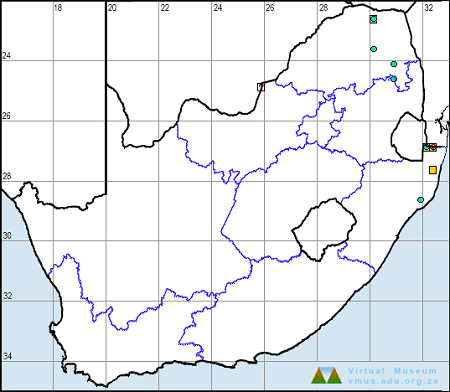Cover photo by Walter Neser.
Find the Graceful Slim in the FBIS database (Freshwater Biodiversity Information System) here.
Family Coenagrionidae
Identification

Near Tshipise, Limpopo
Photo by John Wilkinson
Small size
Length up to 39mm; Wingspan around 46mm.
Aciagrion gracile has a noticeably slender and elongate build. Males have a bright green upper thorax with greenish-blue sides. The long, slender abdomen is black above and brownish below. The terminal segments are bright blue. The postocular spots are bright greenish-blue.
The Graceful Slim is most similar to the Opal Slim (Aciagrion dondoense). The two species are best told apart in the hand by the shape of the claspers.
Click here for more details on identification.
Habitat
The Graceful Slim inhabits the thick bushy verges of shallow grassy pans and marshes. It is found in hot, humid woodland and forest regions.

Photo by Ryan Tippett
Behaviour
Aciagrion gracile is a crepuscular species, that is most active at dusk and is easily overlooked. The males are most often found between thick bush and grasses at the edge of the wetland. Females are usually found among emergent grasses and reeds further out into the water.
The Graceful Slim is active from January to April (see Phenology below).
Status and Conservation
The Graceful Slim is uncommon and highly localised in South Africa. It has likely been under-recorded due to its secretive, crepuscular behaviour. In South Africa, Aciagrion gracile is listed as Vulnerable in the IUCN Red List of Threatened Species. It is listed globally as of Least Concern as it has a wide distribution within the rest of Africa. The Graceful Slim is sensitive to habitat degradation and, for the most part, occurs only in undisturbed habitats.
Distribution
The Graceful Slim is found from South Africa, up through East Africa to Uganda and Ethiopia. It also occurs in West Africa from Congo to Guinea. In South Africa, the Graceful Slim has only been recorded from Limpopo and the north-east of KwaZulu-Natal.
Below is a map showing the distribution of records for Graceful Slim in South Africa. Taken from the OdonataMAP database as at February 2020.

Below is a map showing the distribution of records for Graceful Slim in South Africa. Taken from the OdonataMAP database as of December 2024.

The next map below is an imputed map, produced by an interpolation algorithm, which attempts to generate a full distribution map from the partial information in the map above. This map will be improved by the submission of records to the OdonataMAP section of the Virtual Museum.


Ultimately, we will produce a series of maps for all the odonata species in the region. The current algorithm is a new algorithm. The objective is mainly to produce “smoothed” maps that could go into a field guide for odonata. This basic version of the algorithm (as mapped above) does not make use of “explanatory variables” (e.g. altitude, terrain roughness, presence of freshwater — we will be producing maps that take these variables into account soon). Currently, it only makes use of the OdonataMAP records for the species being mapped, as well as all the other records of all other species. The basic maps are “optimistic” and will generally show ranges to be larger than what they probably are.
These maps use the data in the OdonataMAP section of the Virtual Museum, and also the database assembled by the previous JRS funded project, which was led by Professor Michael Samways and Dr KD Dijkstra.
Phenology

Further Resources
The use of photographs by John Wilkinson and Walter Neser is acknowledged.
Graceful Slim Aciagrion gracile (Sjöstedt, 1909)
Other common names: Emerald-striped Slim (Alt. English); Sierskraaltjie (Afrikaans)
Recommended citation format: Loftie-Eaton M; Navarro R; Tippett RM; Underhill L. 2025. Graceful Slim Aciagrion gracile. Biodiversity and Development Institute. Available online at https://thebdi.org/2020/03/03/graceful-slim-aciagrion-gracile/
References: Tarboton, M; Tarboton, W. (2019). A Guide to the Dragonflies & Damselflies of South Africa. Struik Nature.
Samways, MJ. (2008). Dragonflies and Damselflies of South Africa. Pensoft
Samways, MJ. (2016). Manual of Freshwater Assessment for South Africa: Dragonfly Biotic Index. Suricata 2. South African National Biodiversity Institute, Pretoria

